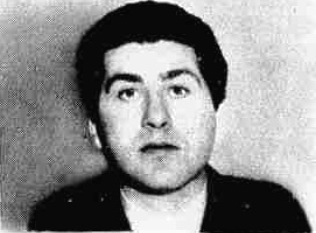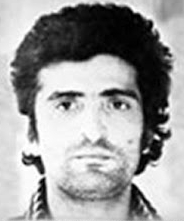
Raffaele Cutolo was an Italian crime boss and leader of the Nuova Camorra Organizzata (NCO), an organisation he built to renew the Camorra. Cutolo had a variety of nicknames including 'o Vangelo, 'o Princepe, 'o Professore and 'o Monaco. Apart from 18 months on the run, Cutolo lived entirely in maximum-security prisons or psychiatric prisons after 1963. At the time of his death he was serving multiple life sentences for murder.
The Nuova Famiglia was an Italian Camorra confederation created in the 1970s and headed by the most powerful Camorra bosses of the time, Carmine Alfieri, the Nuvoletta brothers, Michele Zaza, Luigi Giuliano and Antonio Bardellino, to face Raffaele Cutolo's Nuova Camorra Organizzata, and affiliated with the Sicilian Mafia.

Carmine Alfieri is an Italian Camorra boss, who rose from Piazzolla di Nola to become one of the most powerful members of Neapolitan Camorra in the 1980s. As boss of the Alfieri clan, he was one of the most influential and powerful Camorra bosses from 1984 until his arrest in 1992. Alfieri's nickname is 'o 'ntufato, the angry one, thanks to the dissatisfied, angry sneer he wears constantly.

Pasquale Galasso is a former boss of the Galasso clan, a clan of the Camorra, the Neapolitan crime organization. Since August 1992, he has been a pentito, collaborating with the Italian justice. He revealed many intricate secrets about the Camorra. This led to revelations from other pentiti allowing an insight into the Camorra from the insider's point of view.

Vincenzo Casillo was an Italian Camorrista and the second in command of the Nuova Camorra Organizzata, a Camorra organization in Naples. His nickname was 'o Nirone.
The Nuova Camorra Organizzata was an Italian Camorra criminal organization founded in the late 1970s by a Neapolitan Camorrista, Raffaele Cutolo, in the region of Campania. It was also known by the initials NCO. The organization was established with the purpose of renewing the old rural Camorra, which dealt in contraband cigarettes and extortion schemes in the Neapolitan fruit market. To this end, Cutolo created a structured and hierarchical organization, in stark contrast to the traditional Camorra clans which are usually fragmented. The members of the NCO were often referred to by rival Camorristi and Italian law enforcement as "Cutoliani".
Giovanni Pandico is a former Italian Camorrista who was a member of the Nuova Camorra Organizzata (NCO), a Camorra organization in Naples. Pandico rose to become one of Camorra boss, Raffaele Cutolo's underwriters within the organization. After twelve years of imprisonment, he decided to collaborate with Italian justice and subsequently became a pentito in 1983. Pandico's revelations brought a massive crackdown on the NCO and led to the arrests of over 856 NCO members and affiliates on June 17, 1983, a day labeled by the Neapolitan press as the black day of the NCO.

Pasquale Barra was an Italian Camorrista who was a senior member and hitman for the Nuova Camorra Organizzata (NCO), a Camorra organization in Naples. Barra has the distinction of being the first NCO member to become a pentito, when he decided to collaborate with Italian Justice in 1982.
Giovanni Melluso was an Italian criminal. He became a significant informant against the Nuova Camorra Organizzata (NCO), a Camorra organization in Naples. He would be used by the Italian Justice Department to testify about the NCO's show business connections in Northern Italy, during the three-year-long Maxi Trial which began in 1983. However, many of his accusations were later proven to be unfounded.
Pasquale D'Amico is a former Italian Camorrista who was a senior member of the Nuova Camorra Organizzata (NCO), a Camorra organization in Naples. His nickname was 'o Cartunaro. D'Amico defected from the NCO and subsequently became a pentito in 1983. Among the pentiti, D'Amico was one of the highest-ranking due to his position within the NCO. He was the first high-ranking NCO informant to reveal Neapolitan crime boss, Raffaele Cutolo links with the Calabrian 'Ndrangheta.

Francesco Turatello was an important Italian crime figure, and mob boss who operated during the 1970s mainly in the city of Milan. He was popularly known by his pseudonym Francis Turatello. His nickname was "Faccia d'Angelo".
Luigi Giuliano is a former Italian Camorrista who was the boss of the powerful Giuliano clan based in the district of Forcella, Naples. He had multiple nicknames including "'o rre" and "Lovigino", which is an amalgamation of Luigi and love. In 2002, he decided to collaborate with Italian law enforcement and became a pentito, a co-operating witness against organised crime.

Antonio Bardellino was a powerful Neapolitan Camorrista and boss of the Casalesi clan, having a prominent role in the organized crime in the province of Caserta during the 1980s. He was one of the last of the old-style Camorra godfathers.
The Lo Russo clan was a Neapolitan Camorra clan operating on its territory within the city of Naples, concentrated specifically in the area of Miano, whose control extended throughout numerous neighborhoods in the north of the city for more than three decades. Since the fall of all the Lo Russo brothers, and the numerous arrests of most of its affiliates, the organization is considered overthrown.

The Vollaro clan is a Neapolitan Camorra clan operating in the area east of Naples, more specifically in the town of Portici and San Sebastiano al Vesuvio, a small village in the Vesuvius area.
The Alfieri clan was a Neapolitan Camorra clan operating on the north-east of Naples, with its sphere of influence in the municipalities of Saviano and Nola.
Giuseppe Puca was an Italian Camorrista, and the right hand of Raffaele Cutolo, boss of the Nuova Camorra Organizzata (NCO). He was known among criminal circles as 'o Giappone, due to his Japanese looks.

Umberto Ammaturo, also known as 'o pazzo, is a former Italian criminal and a member of the Neapolitan Camorra, a Mafia-type organisation in Italy. He specialized in cocaine trafficking from South America. He was included in the list of most wanted fugitives in Italy until his capture in May 1993. A month later he decided to become a pentito, a state witness breaking omertà, or code of silence.

Pasquale Scotti is an Italian criminal and boss of the Camorra—a Mafia-type organisation in Naples and Campania—involved in the Nuova Camorra Organizzata (NCO), headed by Raffaele Cutolo.
The Giuliano clan was a powerful Neapolitan Camorra clan that had its base in the area of Forcella, in Naples. Its sphere of influence extended to all the centre of the city of Naples for over four decades.









